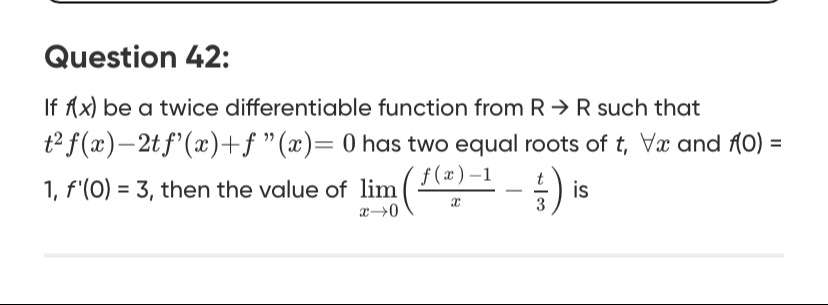Question
Question: If $f(x)$ be a twice differentiable function from R → R such that $t^2 f(x) - 2tf'(x) + f''(x) = 0$ ...
If f(x) be a twice differentiable function from R → R such that t2f(x)−2tf′(x)+f′′(x)=0 has two equal roots of t, ∀x and f(0)=1, f′(0)=3, then the value of limx→0(xf(x)−1−3t) is

2
Solution
The condition that the quadratic equation t2f(x)−2tf′(x)+f′′(x)=0 has two equal roots in t implies that its discriminant is zero. The discriminant is (−2f′(x))2−4(f(x))(f′′(x)). Setting this to zero gives 4(f′(x))2−4f(x)f′′(x)=0, which simplifies to (f′(x))2=f(x)f′′(x).
This differential equation can be rewritten as f′(x)f′′(x)=f(x)f′(x). Integrating both sides with respect to x yields ln∣f′(x)∣=ln∣f(x)∣+C1, which leads to f′(x)=kf(x) for some constant k.
The solution to f′(x)=kf(x) is f(x)=Aekx. Using the initial condition f(0)=1, we get Aek⋅0=1, so A=1. Thus, f(x)=ekx. The derivative is f′(x)=kekx. Using the initial condition f′(0)=3, we get kek⋅0=3, so k=3. Therefore, the function is f(x)=e3x.
The value of the repeated root t for the quadratic equation t2f(x)−2tf′(x)+f′′(x)=0 is given by t=2f(x)2f′(x)=f(x)f′(x). Substituting f(x)=e3x and f′(x)=3e3x, we find t=e3x3e3x=3. So, t is a constant value of 3.
The limit to evaluate is limx→0(xf(x)−1−3t). Substituting f(x)=e3x and t=3, we get: limx→0(xe3x−1−33)=limx→0(xe3x−1−1) We know the standard limit limy→0yey−1=1. By setting y=3x, we have limx→0xe3x−1=limx→03xe3x−1⋅3=1⋅3=3. Alternatively, limx→0xf(x)−1 is the definition of f′(0). Given f′(0)=3, the limit is f′(0)−3t=3−33=3−1=2.
